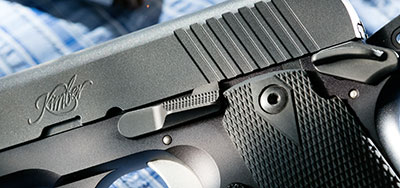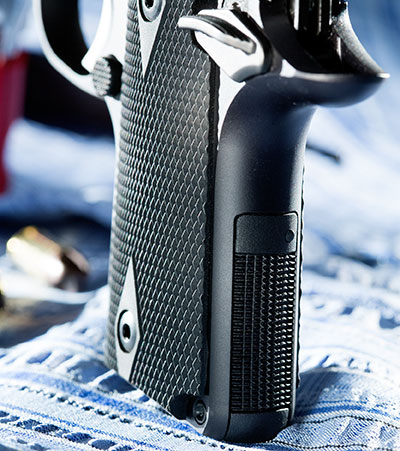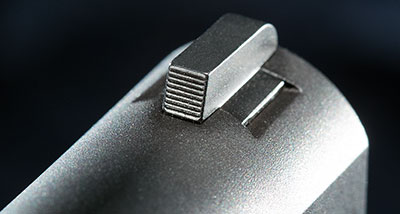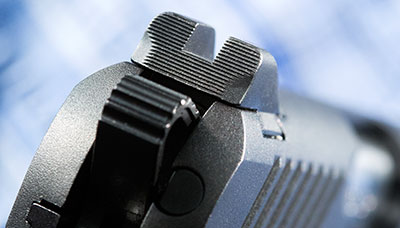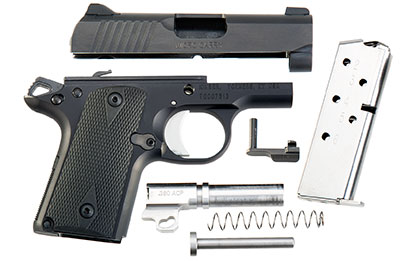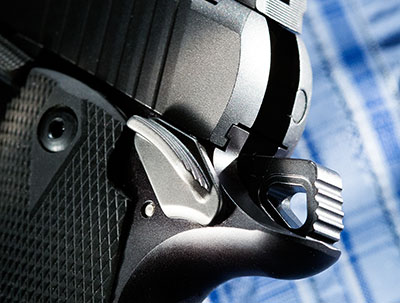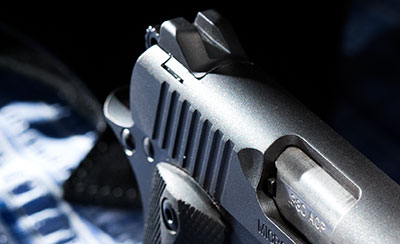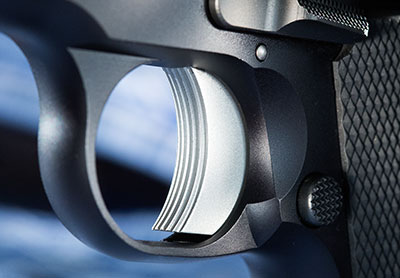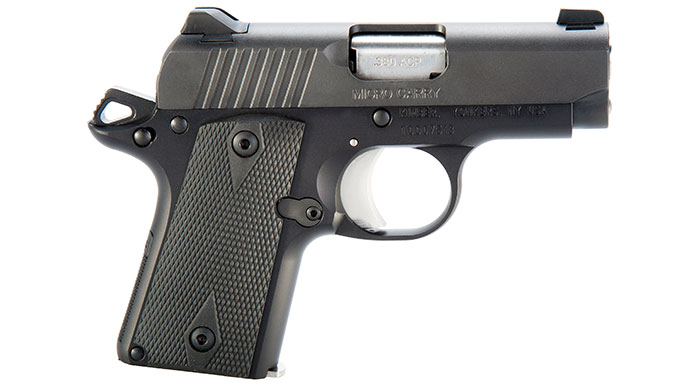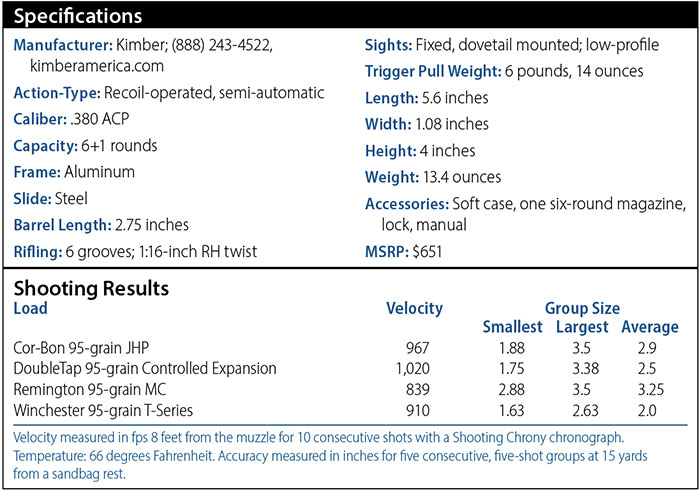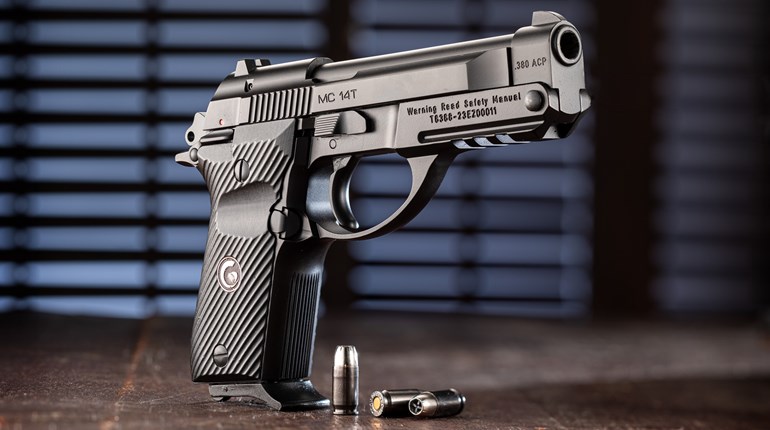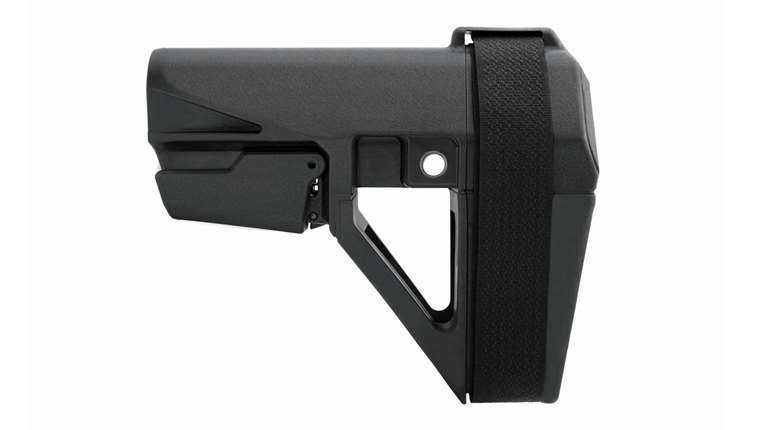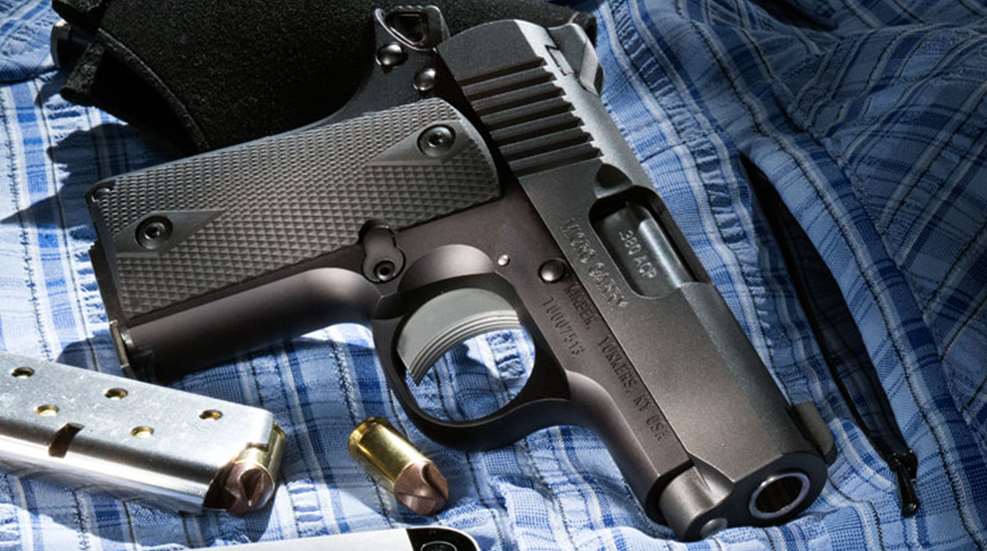
In spite of so many experts vilifying “mouse guns” over the past few decades, the .380 ACP has staged—and continues to stage—an incredible comeback in the world of self-defense handguns. I attribute this to three major factors. First, ammunition manufacturers have invested great effort in both improving performance of .380 ACP ammo and educating the public on those improvements. Second, American shooters have totally embraced the changes in laws regarding the issuance of concealed-carry permits and have flooded law enforcement offices around the country with applications. Third, no matter how small one makes a 9 mm pistol, 380s are smaller, easier to conceal and more comfortable to carry.
Enter Kimber’s Micro Carry, a miniature 1911 in .380 ACP that should tickle the fancy of all who feel “Old Slabsides” may just be the greatest invention of all time. The obvious difference is size, with the Micro having a 2.75-inch barrel, overall length just longer than 5.5 inches, 13.4-ounce weight and, of course, the .380 ACP chambering.
Like its big brother, the Micro is a recoil-operated, semi-automatic pistol that fires single action from a closed breech. The standard magazine holds six rounds and fits flush with the base of the pistol. A slightly longer magazine that holds seven rounds is available as an accessory. It features a short “bumper” at its base that makes for easier and more reliable seating with one firm push of the support hand during a speed reload.
The Micro has many of the safety features and devices with which we’ve grown familiar on full-size service pistols, including an external safety, sear disconnect, firing-pin block and a hammer safety notch. Operating controls like the magazine release, slide release and thumb safety are all similar to a 1911, but are slightly more difficult to run than on a duty-size pistol owing to their requisite small size.
The Micro Carry I received is the basic model with barrel and slide machined from stainless steel and an aluminum frame. Both front and rear sights are steel rather than plastic and are dovetail-mounted in the slide. Windage adjustments are possible simply by drifting either front or rear sight right or left. Changing elevation requires contacting Kimber for a taller or shorter replacement front-sight blade. The sights are larger than I recall on other 380s, with a deep, square notch in the rear and black, parallel post up front. The sight picture was superb, almost bullseye-shooting quality, when I shot five-shot groups for accuracy in the afternoon sunlight. Kimber has other models of the Micro with night sights that might suit you better for potential nighttime encounters, or dealing with sudden threats in dimly lit areas like underground garages.
Usually a custom touch, the Micro’s ejection port is lowered and flared for extra reliability, while the magazine well has been beveled to help seat the replacement magazine as quickly and efficiently as possible. There are serrations at the rear of the slide for that extra bit of positive control when manually manipulating the slide.
While the grip’s frontstrap is smooth, the rubber grip panels and mainspring housing assembly have a checkered finish for enhanced control of the pistol during rapid fire. Although .380 ACP handguns are not known for heavy recoil, all guns obey Newton’s second law, and having some textured surfaces to resist gun movement—particularly on a gun this small—is a good idea. I have difficulty using the word “beavertail” in describing the features on a pistol this size, but the backstrap does extend around and beyond the Commander-style hammer and protects the web of the shooting hand from slide cuts, which is a nice touch.
The Micro arrived with three of the flush-fitting, six-round magazines. All three had holes drilled in the base, so attaching bumper pads should be simple, even for a guy with my limited tool skills. With these short magazines in the gun, only the two middle fingers of my shooting hand fit on the grip, with my pinky curled against my palm under the frame. This might change with an extended magazine, but not having one of the longer mags for testing, I can’t address that for certain. Given the .380’s light recoil, the pistol was not difficult to control in rapid fire, particularly with a proper two-hand grip. If, for any reason, you had to fire with just one hand, you might have to do a little grip-shifting before the magazine is empty, so some one-handed practice would be in order. In fact, a little one-handed practice is a good idea with any self-defense handgun, particularly a small pocket pistol like this one.
The thumb safety is much easier to take off than to engage. With the gun held in a firing position, pressing the shooting-hand thumb downward easily swiped off the safety lever. To put the safety back on, I had to change my grip and use the end of my thumb to apply sufficient upward force. I also had to shift my grip to reach the magazine-release button, which was hardly surprising for a pistol this small.
Whether or not you can reach the release button without moving your hand, you still must get the lower part of your palm and your little finger out from beneath the magazine well so the magazine can slide out. When that’s done properly, the empty magazine flew out of the gun, readying it for a fresh mag.
Interestingly, with a firing grip, the thumb of my shooting hand can reach and operate the slide-lock lever. Perhaps this falls into the bad news/good news category. It’s possible that, depending on your grip, you might depress the slide-lock lever while shooting, thus preventing the slide from locking rearward after the last shot. This is not necessarily fatal—the click of the hammer on an empty chamber serves the same purpose as being unable to press the trigger with the slide locked back. Both are clues that you need to do something else, in this case, reload. If you’re familiar with your handgun, the momentary confusion shouldn’t cost you too much time. The good news is being able to reach and operate the lever with your shooting hand gives you an option for sending the slide forward that you don’t always have on a larger pistol.
I’m not saying you should abandon the technique you learned in training. I’m simply saying there is another option available that will let you stay in the fight should you be unable to use your support hand or arm. A related positive, one which is always appreciated on a defensive hand- gun, is the absence of a magazine disconnect—even with the magazine removed, the Micro will fire if there is a round in the chamber.
Because of the almost target-style sights and short, single-action 1911 trigger pull, I expected the little Micro to perform well in accuracy testing, and I was not disappointed. I don’t have a setup for testing handgun accuracy from a machine rest. I rest my forearms on something, usually a range bag, and send five rounds downrange. There are no rest or refreshment breaks between shots. My one concession to maximizing accuracy is that I use the fingerprint pad of my trigger finger to press the trigger straight back as smoothly as possible. The pistol’s group sizes speak for themselves.
When training for a life-threatening encounter, however, I slide my finger farther into the trigger guard and contact the trigger at the first joint of my trigger finger. In this scenario, I’m trying to shoot faster, or at least establish some rhythm, simulating the multiple shots and repeat sight pictures that will most likely be required to finish a fight. Doing this with the tiny Micro required an adjustment in my shooting grip relative to the position of my support hand, because my trigger finger extended through the trigger guard and rubbed against my other hand, making a consistent trigger pull extremely difficult. If you have exceptionally long fingers, you may have to make a more-dramatic grip adjustment than I did. For those who have carried small pocket revolvers, this isn’t such a big deal, because they’ve used a different grip for tiny guns. If you’ve only shot and trained with duty-size semi-automatics, you might have a bit more difficulty making the adjustment to a small-pistol hold.
A good way to judge a tiny semi-auto is to compare it with a small-frame revolver. The two platforms strike me as competing for the same self-defense role—that of pocket pistol. Both are small and lightweight, meaning they can be carried totally concealed in a pocket (depending on your clothes) without printing or distorting the garment. Both require a pocket holster that covers the trigger guard and must be the only item carried in that pocket. Since the Micro has an external thumb safety, I’d recommend using a holster that covers the safety lever so it can’t be accidentally disengaged while in the pocket. My basic inclination would be to carry the Micro in the inner, hook-and-loop chest pocket of a 5.11 Tactical shirt, which would allow access to the gun whenever seated, particularly in a car with a seat belt across my chest, but I’d like to spend more time evaluating this method. My other thought would be to put it in one of the bellyband rigs held snugly against the torso underneath the shirt. This would be slightly less accessible, but would eliminate any chance of wardrobe sag giving away my status as an armed citizen.
Again, some field time would be in order before reaching any formal conclusions. While I think of the little Kimber as a pocket pistol, there’s no reason not to carry the Micro in a conventional belt holster. Galco offers the Stinger holster, which fits the Micro perfectly and will let you carry the gun concealed in complete comfort all day. It’s just that the little pistol’s compactness suggests it’s destined for a concealed-carry role in the most minimal wardrobe socially acceptable, in a pocket or belly band.
The Micro is a nicely executed ultracompact handgun with rough surfaces where you need them for purchase and metal edges gently rounded where they might develop blisters over a lengthy training session. The bottom edge of the slide was a tad sharp, but it didn’t contact my hand during the 150 rounds or so I fired. The bottom edge of the mainspring housing, which does contact the palm of your hand when shooting, could also stand the gentle touch of a buffing wheel, but given the mild recoil of .380 ACP, I had no blisters or abrasions at the end of the day.
The Micro functioned perfectly and placed its rounds exactly where I pointed the sights. It’s comfortable to carry and easy to conceal. What more could you ask of a compact, defensive pistol?
Enter Kimber’s Micro Carry, a miniature 1911 in .380 ACP that should tickle the fancy of all who feel “Old Slabsides” may just be the greatest invention of all time. The obvious difference is size, with the Micro having a 2.75-inch barrel, overall length just longer than 5.5 inches, 13.4-ounce weight and, of course, the .380 ACP chambering.
Like its big brother, the Micro is a recoil-operated, semi-automatic pistol that fires single action from a closed breech. The standard magazine holds six rounds and fits flush with the base of the pistol. A slightly longer magazine that holds seven rounds is available as an accessory. It features a short “bumper” at its base that makes for easier and more reliable seating with one firm push of the support hand during a speed reload.
The Micro has many of the safety features and devices with which we’ve grown familiar on full-size service pistols, including an external safety, sear disconnect, firing-pin block and a hammer safety notch. Operating controls like the magazine release, slide release and thumb safety are all similar to a 1911, but are slightly more difficult to run than on a duty-size pistol owing to their requisite small size.
The Micro Carry I received is the basic model with barrel and slide machined from stainless steel and an aluminum frame. Both front and rear sights are steel rather than plastic and are dovetail-mounted in the slide. Windage adjustments are possible simply by drifting either front or rear sight right or left. Changing elevation requires contacting Kimber for a taller or shorter replacement front-sight blade. The sights are larger than I recall on other 380s, with a deep, square notch in the rear and black, parallel post up front. The sight picture was superb, almost bullseye-shooting quality, when I shot five-shot groups for accuracy in the afternoon sunlight. Kimber has other models of the Micro with night sights that might suit you better for potential nighttime encounters, or dealing with sudden threats in dimly lit areas like underground garages.
Usually a custom touch, the Micro’s ejection port is lowered and flared for extra reliability, while the magazine well has been beveled to help seat the replacement magazine as quickly and efficiently as possible. There are serrations at the rear of the slide for that extra bit of positive control when manually manipulating the slide.
While the grip’s frontstrap is smooth, the rubber grip panels and mainspring housing assembly have a checkered finish for enhanced control of the pistol during rapid fire. Although .380 ACP handguns are not known for heavy recoil, all guns obey Newton’s second law, and having some textured surfaces to resist gun movement—particularly on a gun this small—is a good idea. I have difficulty using the word “beavertail” in describing the features on a pistol this size, but the backstrap does extend around and beyond the Commander-style hammer and protects the web of the shooting hand from slide cuts, which is a nice touch.
The Micro arrived with three of the flush-fitting, six-round magazines. All three had holes drilled in the base, so attaching bumper pads should be simple, even for a guy with my limited tool skills. With these short magazines in the gun, only the two middle fingers of my shooting hand fit on the grip, with my pinky curled against my palm under the frame. This might change with an extended magazine, but not having one of the longer mags for testing, I can’t address that for certain. Given the .380’s light recoil, the pistol was not difficult to control in rapid fire, particularly with a proper two-hand grip. If, for any reason, you had to fire with just one hand, you might have to do a little grip-shifting before the magazine is empty, so some one-handed practice would be in order. In fact, a little one-handed practice is a good idea with any self-defense handgun, particularly a small pocket pistol like this one.
The thumb safety is much easier to take off than to engage. With the gun held in a firing position, pressing the shooting-hand thumb downward easily swiped off the safety lever. To put the safety back on, I had to change my grip and use the end of my thumb to apply sufficient upward force. I also had to shift my grip to reach the magazine-release button, which was hardly surprising for a pistol this small.
Whether or not you can reach the release button without moving your hand, you still must get the lower part of your palm and your little finger out from beneath the magazine well so the magazine can slide out. When that’s done properly, the empty magazine flew out of the gun, readying it for a fresh mag.
Interestingly, with a firing grip, the thumb of my shooting hand can reach and operate the slide-lock lever. Perhaps this falls into the bad news/good news category. It’s possible that, depending on your grip, you might depress the slide-lock lever while shooting, thus preventing the slide from locking rearward after the last shot. This is not necessarily fatal—the click of the hammer on an empty chamber serves the same purpose as being unable to press the trigger with the slide locked back. Both are clues that you need to do something else, in this case, reload. If you’re familiar with your handgun, the momentary confusion shouldn’t cost you too much time. The good news is being able to reach and operate the lever with your shooting hand gives you an option for sending the slide forward that you don’t always have on a larger pistol.
I’m not saying you should abandon the technique you learned in training. I’m simply saying there is another option available that will let you stay in the fight should you be unable to use your support hand or arm. A related positive, one which is always appreciated on a defensive hand- gun, is the absence of a magazine disconnect—even with the magazine removed, the Micro will fire if there is a round in the chamber.
Because of the almost target-style sights and short, single-action 1911 trigger pull, I expected the little Micro to perform well in accuracy testing, and I was not disappointed. I don’t have a setup for testing handgun accuracy from a machine rest. I rest my forearms on something, usually a range bag, and send five rounds downrange. There are no rest or refreshment breaks between shots. My one concession to maximizing accuracy is that I use the fingerprint pad of my trigger finger to press the trigger straight back as smoothly as possible. The pistol’s group sizes speak for themselves.
When training for a life-threatening encounter, however, I slide my finger farther into the trigger guard and contact the trigger at the first joint of my trigger finger. In this scenario, I’m trying to shoot faster, or at least establish some rhythm, simulating the multiple shots and repeat sight pictures that will most likely be required to finish a fight. Doing this with the tiny Micro required an adjustment in my shooting grip relative to the position of my support hand, because my trigger finger extended through the trigger guard and rubbed against my other hand, making a consistent trigger pull extremely difficult. If you have exceptionally long fingers, you may have to make a more-dramatic grip adjustment than I did. For those who have carried small pocket revolvers, this isn’t such a big deal, because they’ve used a different grip for tiny guns. If you’ve only shot and trained with duty-size semi-automatics, you might have a bit more difficulty making the adjustment to a small-pistol hold.
A good way to judge a tiny semi-auto is to compare it with a small-frame revolver. The two platforms strike me as competing for the same self-defense role—that of pocket pistol. Both are small and lightweight, meaning they can be carried totally concealed in a pocket (depending on your clothes) without printing or distorting the garment. Both require a pocket holster that covers the trigger guard and must be the only item carried in that pocket. Since the Micro has an external thumb safety, I’d recommend using a holster that covers the safety lever so it can’t be accidentally disengaged while in the pocket. My basic inclination would be to carry the Micro in the inner, hook-and-loop chest pocket of a 5.11 Tactical shirt, which would allow access to the gun whenever seated, particularly in a car with a seat belt across my chest, but I’d like to spend more time evaluating this method. My other thought would be to put it in one of the bellyband rigs held snugly against the torso underneath the shirt. This would be slightly less accessible, but would eliminate any chance of wardrobe sag giving away my status as an armed citizen.
Again, some field time would be in order before reaching any formal conclusions. While I think of the little Kimber as a pocket pistol, there’s no reason not to carry the Micro in a conventional belt holster. Galco offers the Stinger holster, which fits the Micro perfectly and will let you carry the gun concealed in complete comfort all day. It’s just that the little pistol’s compactness suggests it’s destined for a concealed-carry role in the most minimal wardrobe socially acceptable, in a pocket or belly band.
The Micro is a nicely executed ultracompact handgun with rough surfaces where you need them for purchase and metal edges gently rounded where they might develop blisters over a lengthy training session. The bottom edge of the slide was a tad sharp, but it didn’t contact my hand during the 150 rounds or so I fired. The bottom edge of the mainspring housing, which does contact the palm of your hand when shooting, could also stand the gentle touch of a buffing wheel, but given the mild recoil of .380 ACP, I had no blisters or abrasions at the end of the day.
The Micro functioned perfectly and placed its rounds exactly where I pointed the sights. It’s comfortable to carry and easy to conceal. What more could you ask of a compact, defensive pistol?
